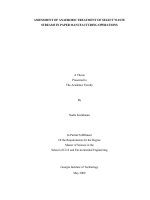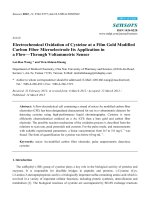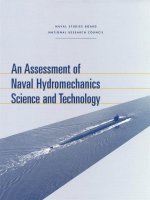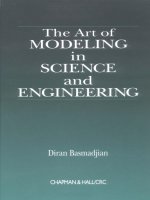anaerobic oxidation of methane 2002 science
Bạn đang xem bản rút gọn của tài liệu. Xem và tải ngay bản đầy đủ của tài liệu tại đây (229.75 KB, 3 trang )
10. T. D. Schaal, T. Maniatis, Mol. Cell. Biol. 19, 1705
(1999).
11. H. Tian, R. Kole, Mol. Cell. Biol. 15, 6291 (1995).
12. S. M. Berget, J. Biol. Chem. 270, 2411 (1995).
13. C. F. Bourgeois, M. Popielarz, G. Hildwein, J. Stevenin,
Mol. Cell. Biol. 19, 7347 (1999).
14. A. Kanopka, O. Muhlemann, G. Akusjarvi, Nature 381,
535 (1996).
15. L. M. McNally, M. T. McNally, Mol. Cell. Biol. 18, 3103
(1998).
16. B. R. Graveley, RNA 6, 1197 (2000).
17. Supporting data are on Science Online.
18. J. D. Thompson, D. G. Higgins, T. J. Gibson, Nucleic
Acids Res. 22, 4673 (1994).
19. D. L. Black, Genes Dev. 5, 389 (1991).
20. Z. Dominski, R. Kole, Mol. Cell. Biol. 11, 6075 (1991).
21.
, Mol. Cell. Biol. 12, 2108 (1992).
22. R F. Yeh, C. B. Burge, data not shown.
23. M. Tu, W. Tong, R. Perkins, C. R. Valentine, Mutat. Res.
432, 15 (2000).
24. C. R. Valentine, Mutat. Res. 411, 87 (1998).
25. H. X. Liu, L. Cartegni, M. Q. Zhang, A. R. Krainer,
Nature Genet. 27, 55 (2001).
26. We thank B. Blencowe, L. Chasin, L. Lim, D. Lipman, and
D. Riordan for helpful comments on the manuscript; H.
Cargill for help with the figures; T. Cooper for
generously providing us with the SXN minigene con-
struct; and anonymous reviewers for helpful sugges-
tions. Supported by a Functional Genomics Innovation
Award from the Burroughs Wellcome Fund (C.B.B.,
P.A.S.) and by NIH grant 1 R01 HG02439-01 (C.B.B.).
Supporting Online Material
www.sciencemag.org/cgi/content/full/1073774/DC1
Materials and Methods
Figs. S1 to S5
Tables S1 to S6
References
9 May 2002; accepted 2 July 2002
Published online 11 July 2002;
10.1126/science.1073774
Include this information when citing this paper.
Microbial Reefs in the Black Sea
Fueled by Anaerobic Oxidation
of Methane
Walter Michaelis,
1
* Richard Seifert,
1
Katja Nauhaus,
2
Tina Treude,
2
Volker Thiel,
1
Martin Blumenberg,
1
Katrin Knittel,
2
Armin Gieseke,
2
Katharina Peterknecht,
1
Thomas Pape,
1
Antje Boetius,
3
Rudolf Amann,
2
Bo Barker Jørgensen,
2
Friedrich Widdel,
2
Jo¨rn Peckmann,
4
Nikolai V. Pimenov,
5
Maksim B. Gulin
6
Massive microbial mats covering up to 4-meter-high carbonate buildups prosper
at methane seeps in anoxic waters of the northwestern Black Sea shelf. Strong
13
C depletions indicate an incorporation of methane carbon into carbonates,
bulk biomass, and specific lipids. The mats mainly consist of densely aggregated
archaea (phylogenetic ANME-1 cluster) and sulfate-reducing bacteria (Desul-
fosarcina/Desulfococcus group). If incubated in vitro, these mats perform
anaerobic oxidation of methane coupled to sulfate reduction. Obviously,
anaerobic microbial consortia can generate both carbonate precipitation and
substantial biomass accumulation, which has implications for our understand-
ing of carbon cycling during earlier periods of Earth’s history.
Until recently, it was believed that only aerobic
bacteria, depending on oxygen as an electron
acceptor, build up substantial biomass from
methane carbon in natural habitats (1). Because
biogenic methane is strongly depleted in
13
C, a
worldwide negative excursion in the isotopic
signature of organic matter around 2.7 Ga (1
Ga ϭ 10
9
years) ago was taken as an argument
for methanotrophy and, consequently, an early
oxygenation of the Earth’s atmosphere (2).
However, recent investigations have shown the
existence of methane-consuming associations
of archaea and sulfate-reducing bacteria (SRB)
in anoxic marine sediments (3, 4).
Microorganisms capable of anaerobic
growth on methane have not been cultivated
so far, and the biochemical pathway of the
anaerobic oxidation of methane (AOM) re-
mains speculative. Analyses of depth profiles
and radiotracer studies in marine sediments
(5, 6 ) as well as molecular (7–10) and petro-
graphic studies (11) argue for AOM (12)asa
crucial process that channels
13
C-depleted
methane carbon into carbonate and microbial
biomass. Through AOM mediated by consor-
tia of archaea and SRB, methane is oxidized
with equimolar amounts of sulfate, yielding
carbonate and sulfide, respectively (13). Gen-
eration of alkalinity favors the precipitation
of methane-derived bicarbonate according to
the following net reaction:
CH
4
ϩSO
4
2Ϫ
ϩCa
2ϩ
3 CaCO
3
ϩH
2
SϩH
2
O
Here, we provide evidence that vast amounts
of microbial biomass may accumulate in an
anoxic marine environment because of the
use of methane as an electron donor for sul-
fate reduction (SR) and as an organic carbon
source for cell synthesis.
In the northwestern Black Sea, hundreds of
active gas seeps occur along the shelf edge west
of the Crimea peninsula at water depths be-
tween 35 and 800 m (14 ). At some of the
shallow Crimean seeps, microbial mats were
found associated with isotopically light carbon-
ates. Aspects of the microbiology, sedimentol-
ogy, mineralogy, and selected biomarker prop-
erties of these deposits were recently described
(11, 15–17). We explored the seeps on the
lower Crimean shelf with the manned submers-
ible JAGO from aboard the Russian R/V Pro-
fessor Logachev. During dives to a seep area at
44°46ЈN, 31°60ЈE, we discovered a reef con-
sisting of up to 4-m-high and 1-m-wide micro-
bial structures projecting into permanently an-
oxic bottom water at a depth around 230 m
(Fig. 1A). These buildups are formed by up to
10-cm-thick microbial mats that are internally
stabilized by carbonate precipitates (Fig. 1A).
From holes in these structures, streams of
gas bubbles emanate into the water column
(Fig. 1A). The gas contains about 95% meth-
ane [see supporting online material (SOM)].
In cross section, the outside of the soft mat
has a dark gray to black color (Fig. 1B).
Inside the structure, most of the mat is pink to
brownish. The interior rigid parts are porous
carbonates (aragonite and calcite with up to
14% MgCO
3
). Much of the structures con-
sists of interconnected, irregularly distributed
cavities and channels filled with seawater and
gases. Apparently, the cavernous structure of
these precipitates enables methane and sul-
fate to be transported and distributed through-
out the massive mats. Smaller microbial
structures and nodules from nearby areas
were of the same morphology, with compact
mat enclosing calcified parts and cavities.
Obviously, the microorganisms do not grow
on preformed carbonates but induce and
shape their formation. Stable carbon isotope
analyses of the carbonates yielded ␦
13
C val-
ues ranging from Ϫ25.5 to Ϫ32.2 per mil
(‰) [for methods, see (11)]. Compared with
the ␦
13
C values of dissolved inorganic carbon
in the Black Sea water column from ϩ0.8‰
at surface to Ϫ6.3‰ at depth (18), these
values indicate that a major portion of the
carbonate originates from the oxidation of
1
Institute of Biogeochemistry and Marine Chemistry,
University of Hamburg, Bundesstrasse 55, 20146
Hamburg, Germany.
2
Max Planck Institute for Marine
Microbiology, Celsiusstrasse 1, 28359 Bremen, Ger-
many.
3
Alfred Wegener Institute for Polar and Marine
Research, 27515 Bremerhaven, and International Uni-
versity Bremen, 28725 Bremen, Germany.
4
Geowis-
senschaftliches Zentrum, University of Go¨ttingen,
Goldschmidtstrasse 3, 37077 Go¨ttingen, Germany.
5
Institute of Microbiology, Russian Academy of Sci-
ences, pr. 60-letiya Oktyabrya 7, k. 2, Moscow,
117811, Russia.
6
Institute of Biology of Southern
Seas, National Academy of Sciences of Ukraine, pr.
Nakhimova 2, Sevastopol, Ukraine.
*To whom correspondence should be addressed. E-
mail:
R EPORTS
www.sciencemag.org SCIENCE VOL 297 9 AUGUST 2002 1013
methane. The methane seeping from the mi-
crobial structures and from nearby sediment
pockmarks is of biogenic origin, as indicated
by ␦
13
C values of Ϫ62.4 to Ϫ68.3‰ (n ϭ 6)
(SOM) and most probably evolves from a
deeper sedimentary source.
Samples of living microbial mat were re-
trieved to investigate their microbiological
and chemical composition as well as their
catabolic activity. A short-term labeling ex-
periment with added [
14
C]methane and
[
35
S]sulfate (SOM) was performed directly
after sampling. Pieces of mat incubated for 5
days in bottom water amended with methane
(1.8 mM) exhibited AOM to carbon dioxide
at a rate of 18 (Ϯ12) mol (gram dry
weight)
Ϫ1
d
Ϫ1
and SR at a rate of 19 (Ϯ1)
mol (gram dry weight)
Ϫ1
d
Ϫ1
(ϮSD; n ϭ
3). In controls without mat samples, AOM
and SR were below the detection limit. Re-
sults are in agreement with a stoichiometry of
1:1 between AOM and SR, as in experiments
with sediment samples from a gas hydrate
area (13). Methane-dependent SR to sulfide
was also shown by chemical quantification
with mat samples immediately incubated
with and without methane, respectively (in-
cubation time, 60 days). SR rates under an
atmosphere of methane were 34 (Ϯ5.8) mol
(gram dry weight)
Ϫ1
d
Ϫ1
(ϮSD; n ϭ 6),
whereas rates under nitrogen were 2.8
(Ϯ0.55) mol (gram dry weight)
Ϫ1
d
Ϫ1
(ϮSD; n ϭ 3), probably because of gradual
decay of biomass. Chemical quantification in
another, long-term incubation experiment
(166 days) again corroborated the 1:1 stoi-
chiometry between AOM and SR (13). All
these experiments indicate that methane is the
main or only electron donor that accounts for
SR and hence the buildup of the massive mat
and carbonate structures in the investigated
region of the Black Sea.
In extracts from homogenized mat samples,
we observed isoprene-based constituents of ar-
chaeal lipids and hydrocarbons, such as ar-
chaeol, crocetane, and C
40
isoprenoids (acyclic,
mono-, and dicyclic biphytanes) (Table 1) [see
SOM (fig. S1)]. A second compound cluster
encompassed nonisoprenoid, linear, and mono-
methyl-branched carbon skeletons of presum-
ably bacterial origin. Most prominent among
these structures are -3 monomethylated (an-
teiso-)C
15
carbon chains bound in glycerol
esters and glycerol diethers. No such lipids
were found in a surface sediment of a nearby
non-seep area, whereas similar biomarker pat-
terns typically occur at modern and fossil meth-
ane seeps and were consistently related to con-
tributions from methane-consuming archaea
and associated SRB (Table 1). Indeed, strong
13
C depletions of the bulk biomass (Ϫ72.2‰)
and of the bacterial and archaeal lipids there
(Table 1) indicate that the mat microbiota must
have incorporated methane-derived carbon into
their biomass. Hence, archaeal AOM and bac-
terial SR are relevant processes fueling biomass
production and reef formation in this perma-
nently anaerobic seep environment.
To directly trace the uptake and transforma-
tion of methane into organic and inorganic mat-
ter, we incubated 1-cm-thick pieces of micro-
bial mat with radioactive methane (
14
CH
4
) and
analyzed thin sections with a -microimager
that provides two-dimensional images of radio-
activity distribution (see SOM). Incorporation
of radiotracer into the solid phase was recorded
throughout the sections, which demonstrates
that methane is readily assimilated into the mi-
crobial mat (Fig. 2E). Upon acidification of the
thin sections, about 25% of the
14
C radioactiv-
ity was lost. Obviously, a fraction of the meth-
ane carbon had been precipitated as carbonate.
This approach provides direct laboratory evi-
dence for methane-fueled calcification and for
the microbially mediated formation of carbon-
ate structures.
Epifluorescence microscopy of sections of
microbial mat revealed dense aggregations of
archaea and bacteria (Fig. 2) (see SOM). The
mats are penetrated by systems of microchan-
nels that may enable advective exchange with
Fig. 1. Image of microbial reef
structures (as seen from the sub-
mersible). (A) Tip of a chimney-
like structure. Free gas emanates
in constant streams from the mi-
crobial structures into the anoxic
seawater. (B) Broken structure of
about 1 m height. The surface of
the structure consists of gray-
black microbial mat; the interior
of the massive mat is pink. The
greenish-gray inner part of the
structure consists of porous
carbonate, which encloses mi-
crobial mats and forms irregu-
lar cavities.
Fig. 2. Fluorescence image showing a thin section of the pink mat. Scale bars indicate different
microscopic magnifications. The arrow marks the outside of the microbial mat. (A) Thin section of
mat stained with 4Ј,6-diamidino-2-phenylindole (see SOM). (B) Archaea of the cluster ANME-1
were targeted with a red-fluorescent group-specific oligonucleotide probe. SRB were targeted with
a probe specific for a cluster of ␦-proteobacteria in the Desulfosarcina/Desulfococcus group and
fluoresce green. These two populations comprise the bulk biomass in the microbial mat. (C)
Microcolonies of SRB are surrounded by bulk ANME-I cell clusters. (D) ANME-1 cells have a unique
rectangular shape; SRB are small coccoid cells. Single SRB cells are dispersed throughout the
ANME-I cell clusters. (E) -imager micrograph of a thin section of mat incubated with
14
CH
4
(see
SOM). The micrograph shows incorporated radioactivity of the mat after acidification. Green and
red areas indicate
14
C uptake.
R EPORTS
9 AUGUST 2002 VOL 297 SCIENCE www.sciencemag.org1014
the surrounding seawater (Fig. 2A). The micro-
channels radiate out from the inner calcified
part of the mat system and make up between 20
and 40% of the bulk mat volume. Fluorescence
in situ hybridization (see SOM) shows that the
mat biomass is dominated by one archaeal pop-
ulation comprising at least 70% of the mat
biomass and belonging to the cluster ANME-1
(Fig. 2, B, C, and D). ANME-1 is only distantly
related to the Methanosarcinales and the
ANME-2 cluster, which forms consortia with
SRB and is known to be capable of AOM (3, 4,
6). Nevertheless, the microbial mat dominated
by ANME-1 comprises a similar pattern of the
13
C-depleted archaeal biomarkers crocetane,
pentamethylicosane, pentamethylicosenes, ar-
chaeol, and sn-2-hydroxyarchaeol [see SOM
(fig. S1)], as hydrate ridge sediments (3, 7), in
which archaea of the ANME-2 cluster prevail
(3). The most abundant bacterial population in
the mats from the Black Sea belongs to the
Desulfosarcina/Desulfococcus group, the same
taxon of SRB as found in the ANME-2/SRB
consortium (3).
ANME-1 cells have a cylindrical shape
and are autofluorescent under ultraviolet
light, a feature typical for methanogenic ar-
chaea containing coenzyme F
420
. Their
length is about 3.5 m and their diameter is
about 0.6 m (biovolume, about 1 m
3
). The
coccoid SRB (cell diameter, about 0.6 m;
biovolume, about 0.1 m
3
) occur in larger
clusters of 10 to 50 m diameter (Fig. 2, B
and C). Smaller clusters and single cells of
SRB are dispersed throughout the bulk
ANME-1 biomass (Fig. 2D). A 1-cm
3
mat
contains about 10
12
cells (see SOM), which
corresponds to about 25 mg of carbon.
The growth yield of the mat community is
currently unknown. Prokaryotes deriving their
energy from dissimilatory SR generally have
low growth yields. Pure cultures of SRB grow-
ing on conventional substrates (for example,
organic acids) usually convert only one-tenth of
the totally consumed organic compounds into
cell mass, but the free energy gain obtained (for
example, on lactate, ⌬G around Ϫ100 kJ per
mol of sulfate) remains higher than that of
AOM. Even with high methane partial pressure
as at the active seeps studied (up to about 20
atm), the ⌬G should not exceed Ϫ40 kJ per mol
of methane oxidized (see SOM). Hence, an
even lower growth yield than for conventional
cultures of SRB must be expected for the Black
Sea mats. Consequently, the amount of meth-
ane oxidized for the buildup and maintenance
of the existing mat structures should exceed
their organic carbon content by more than an
order of magnitude.
Microbial mats of the size currently ob-
served are rarely found in oxic environments.
This may reflect the absence of metazoan
grazing and other mortality factors in the
permanently anoxic and sulfidic environment
of the Black Sea. There is increasing evi-
dence that the capacity for AOM is present in
several deep-branching clades of archaea
(19), which indicates an early evolutionary
origin, just as for methanogenesis.
AOM may have influenced the carbon iso-
tope record of the Archaean (20). Moreover,
recent studies suggest that SR has already been
prolific 3.5 Ga ago (21), close to the first occur-
rence of microfossils (3.5 Ga ago) (22) and the
first isotopic traces of bioorganic carbon cycling
(3.8 Ga ago) (23). Hence, AOM may have
represented an important link in the biological
cycling of carbon in an anoxic biosphere. Even
in the absence of free oxygen, methane formed
by anaerobic degradation (fermentation and
methanogenesis) of organic matter could have
been recycled via AOM, leading to substrates
(inorganic carbon and sulfide) for anoxygenic
photosynthesis of new biomass. In this respect,
the microbial reefs discovered at Black Sea
methane seeps suggest how large parts of the
ancient ocean might have looked when oxygen
was a trace element in the atmosphere, long
before the onset of metazoan evolution.
References and Notes
1. R. S. Hanson, T. E. Hanson, Microbiol. Rev. 60,439
(1996).
2. J. M. Hayes, in Global Methanotrophy at the Archean-
Proterozoic Transition, S. Bengtson, J. Bergstro¨m, V.
Gonzalo, A. Knoll, Eds., Nobel Symposium (Columbia
University Press, New York, 1994), pp. 220–236.
3. A. Boetius et al., Nature 407, 623 (2000).
4. V. J. Orphan, C. H. House, K. U. Hinrichs, K. D.
McKeegan, E. F. DeLong, Science 293, 484 (2001).
5. T. Hoehler, M. J. Alperin, D. B. Albert, C. Martens,
Global Biogeochem. Cycles 8, 451 (1994).
6. V. J. Orphan, C. H. House, K. U. Hinrichs, K. D.
McKeegan, E. F. DeLong, Proc. Natl. Acad. Sci. U.S.A.
99, 7663 (2002).
7. M. Elvert, E. Suess, M. J. Whiticar, Naturwissen-
schaften 86, 295 (1999).
8. K U. Hinrichs, J. M. Hayes, S. P. Sylva, P. G. Brewer,
E. F. DeLong, Nature 398, 802 (1999).
9. V. Thiel et al., Geochim. Cosmochim. Acta 63, 3959
(1999).
10. R. D. Pancost et al., Appl. Environ. Microbiol. 66, 1126
(2000).
11. J. Peckmann et al., Marine Geol. 177, 129 (2001).
12. D. L. Valentine, W. S. Reeburgh, Environ. Microbiol. 2,
477 (2000).
13. K. Nauhaus, A. Boetius, M. Kru¨ger, F. Widdel, Environ.
Microbiol. 4, 296 (2002).
14. M. V. Ivanov et al., Dokl. An. USSR 320, 1235 (1991).
15. V. Thiel et al., Marine Chem. 73, 97 (2001).
16. N. V. Pimenov et al., Microbiology 66, 354 (1997).
17. A. Yu. Lien, M. V. Ivanov, N. V. Pimenov, M. B. Gulin,
Microbiology 70, 78 (2002).
18. B. Fry et al., Deep Sea Res. Suppl. 2 38, 1013 (1991).
19. V. J. Orphan et al., Appl. Environ. Microbiol. 67, 1922
(2001).
20. K U. Hinrichs, A. Boetius, in Ocean Margin Systems,
G. Wefer et al., Eds. (Springer-Verlag, Berlin, 2002),
pp. 457– 477.
21. Y. Shen, R. Buick, D. E. Canfield, Nature 410,77
(2001).
22. J. W. Schopf, Science 260, 640 (1993).
23. S. J. Mojszis et al., Nature 384, 55 (1996).
24. M. Elvert, J. Greinert, E. Suess, M. Whiticar, in Natural
Gas Hydrates: Occurrence, Distribution, and Detec-
tion, American Geophysical Union Monograph Series,
Vol. 124, W. Dillon, C. Paull, Eds. (American Geo-
physical Union, Washington, DC, 2001), pp. 115–129.
25. M. Elvert, E. Suess, J. Greinert, M. J. Whiticar, Organ.
Geochem. 31, 1175 (2000).
26. K U. Hinrichs, R. E. Summons, V. J. Orphan, S. P.
Sylva, J. M. Hayes, Organ. Geochem. 31, 1685 (2000).
27. V. Thiel, J. Peckmann, O. Schmale, J. Reitner, W.
Michaelis, Organ. Geochem. 32, 1019 (2001).
28. R. D. Pancost, I. Bouloubassi, G. Aloisi, J. S. Sinninghe
Damste´, the Medinaut Shipboard Party, Organ. Geo-
chem. 32, 695 (2001).
29. We thank the crew of the R/V Professor Logachev and
the JAGO team for excellent collaboration during
field work, and S. Beckmann, S. Ertl, O. Schmale, and
M. Hartmann for analytical work. This study received
financial support through the programs GHOSTDABS
(03G0559A) and MUMM (03G0554A) of the
Bundesministerium fu¨r Bildung und Forschung
(BMBF), the Deutsche Forschungsgemeinschaft (Th
713/2), the University of Hamburg, the ZEIT-Stiftung
Ebelin und Gerd Bucerius, and the Max-Planck-Gesell-
schaft (Germany). This is publication GEOTECH-3 of
the GEOTECHNOLOGIEN program of the BMBF and
the DFG and publication 1 of the research program
GHOSTDABS.
Supporting Online Material
www.sciencemag.org/cgi/content/full/297/5583/1013/
DC1
Materials and Methods
Fig. S1
3 April 2002; accepted 25 June 2002
Table 1. Selected biomarkers, their ␦
13
C values, and most likely biological sources in the Black Sea
microbial mat. The reference column cites previous reports on these compounds in other methane-
related environments. For additional information see SOM.
Compound ␦
13
C (‰) Source Reference
Crocetane (2,6,11,15-
tetramethylhexadecane)
Ϫ94.7 Ϯ 0.7 Archaea (?) (3, 10, 15,
19, 24–27)
2,6,10,15,19-Pentamethylicosane Ϫ95.6 Ϯ0.1 Archaea
Methanosarcinales
(3, 10, 15,
19, 24–27)
Archaeol (2,3-di-O-phytanyl-sn-
glycerol)
Ϫ87.9 Ϯ 0.6 Archaea (3, 8, 10, 19,
24–26, 28)
sn-2-Hydroxyarchaeol
(2-O-3-hydroxyphytanyl-3-O-
phytanyl-sn-glycerol)
Ϫ90.0 Ϯ 1.0 Archaea
Methanosarcinales
(3, 8, 10, 19,
28)
Biphytane (from tetraether after
HI/LiAlH
4
cleavage)
Ϫ91.6 Ϯ 0.6 Archaea (15)
n-Tricos-10-ene Ϫ90.9 Ϯ 0.3 Unknown
(bacteria?)
(27)
Anteiso-pentadecanoic acid
(12-methyltetradecanoic acid)
Ϫ83.9 Ϯ 0.1 SRB (3, 10, 19,
26, 28)
1,2-di-O-12-Methyltetradecyl-sn-
glycerol
Ϫ89.5 Ϯ 0.5 SRB (19, 28)
R EPORTS
www.sciencemag.org SCIENCE VOL 297 9 AUGUST 2002 1015









